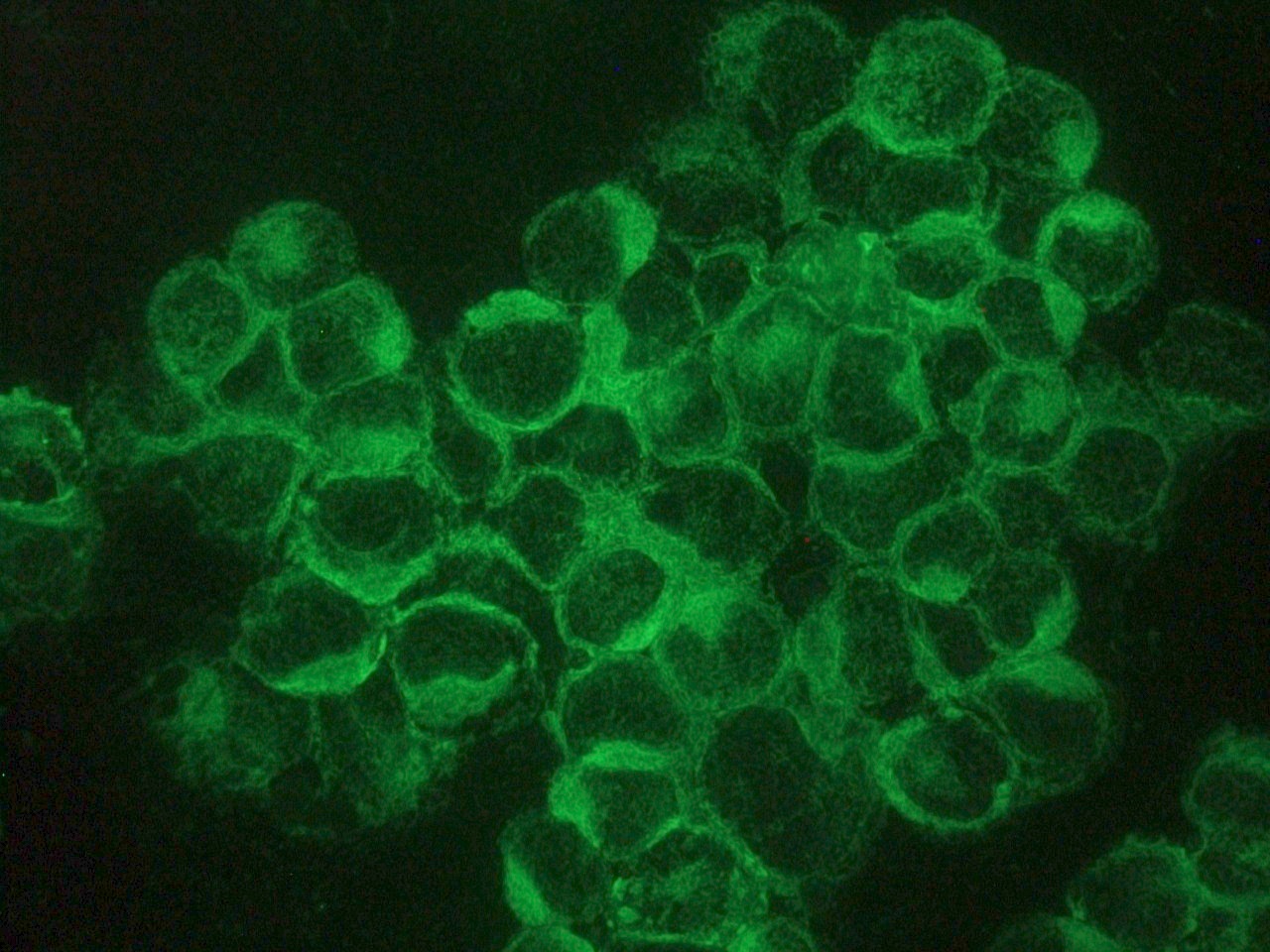Catalogue

Mouse anti Reticulon-1A/B / NSP-A/B
Catalog number: MUB1313P-CE/IVD| Clone | RNL-2 |
| Isotype | IgG1 |
| Product Type |
Primary Antibodies |
| Units | 0.1 mg |
| Host | Mouse |
| Species Reactivity |
Human Monkey Rabbit |
| Application |
Flow Cytometry Immunocytochemistry Immunohistochemistry (frozen) Immunohistochemistry (paraffin) Western Blotting |
Background
Recently, a novel gene family has been identified and characterized, designated the Reticulons because the proteins encoded by these genes are anchored to the membranes of the endoplasmic reticulum. Reticulon-1 was formerly designated NSP for Neuroendocrine-Specific-Protein, because it is specifically expressed in neural and neuroendocrine tissues. The NSP-gene has been mapped by fluorescence in situ hybridization to Human chromosome 14q21-q22. The NSP-gene encodes three overlapping proteins, i.e. Reticulon-1A (NSP-A), Reticulon-1B (NSP-B), and Reticulon-1C (NSP-C). These proteins were found to be anchored to membranes of the endoplasmic reticulum through their common carboxy-terminal regions. Reticulon-1A is a protein with a molecular weight (MW) of about 135 kDa, which occurs in various isoforms presumably depending on the degree of phosphorylation of serine residues. In lung cancer diagnosis Reticulon-1A appeared to be a reliable marker for the detection of neuroendocrine differentiation, since most of the small cell lung carcinoma (SCLC) and carcinoid tumors showed expression of Reticulon-1A. Reticulon-1B is a phosphoprotein with a MW of 45 kDa and is restricted to the lung cancer cell line NCI-H82. Reticulon-1B is sofar not found in Human tissues. Reticulon-1C is a protein with a MW of 23 kDa which is not phosphorylated and is found with Reticulon-1A in SCLC (cell lines) and not in non-SCLC (cell cultures).
Synonyms: Reticulon/ Neuro-endocrine specific protein
Source
RNL-2 is a Mouse monoclonal IgG1 antibody derived by fusion of SP2/0-Ag14 Mouse myeloma cells with spleen cells from a BALB/c Mouse immunized with the small cell lung cancer cell line NCI-H82.
Product
Each vial contains 100 ul 1 mg/ml purified monoclonal antibody in PBS containing 0.09% sodium azide.
Formulation: Each vial contains 100 ul 1 mg/ml purified monoclonal antibody in PBS containing 0.09% sodium azide.
Specificity
RNL-2 recognizes an epitope loCated within the region of amino acids 421-589 of the neuro-endocrine specific protein Reticulon-1A (NSP-A), which is also present in the N-terminal part of Reticulon-1B (NSP-B). In normal tissues, RNL-2 reacts with brain Purkinje cells, pancreatic islet cells, cells in the pituitary gland and some (peripheral) nerve fibers. In addition, a few epithelia show positive staining.
Applications
RNL-2 is useful for immunocytochemistry, immunohistochemistry on frozen and paraffin-embedded tissues, immunoblotting and flow cytometry. Optimal antibody dilution should be determined by titration; recommended range is 1:25 – 1:200 for flow cytometry, and for immunohistochemistry with avidin-biotinylated Horseradish peroxidase complex (ABC) as detection reagent, and 1:100 – 1:1000 for immunoblotting applications.
Storage
The antibody is shipped at ambient temperature and may be stored at +4°C. For prolonged storage prepare appropriate aliquots and store at or below -20°C. Prior to use, an aliquot is thawed slowly in the dark at ambient temperature, spun down again and used to prepare working dilutions by adding sterile phosphate buffered saline (PBS, pH 7.2). Repeated thawing and freezing should be avoided. Working dilutions should be stored at +4°C, not refrozen, and preferably used the same day. If a slight precipitation occurs upon storage, this should be removed by centrifugation. It will not affect the performance or the concentration of the product.
Caution
When used for in vitro diagnostic purposes results must be put within the context of other diagnostic tests as well as the clinical history of the patient by a certified professional before final interpretation. Analyses performed with this antibody should be paralleled by positive and negative controls. If unexpected results are obtained which cannot be attributed to differences in laboratory procedures, please contact us. This product may contain hazardous ingredients. Please refer to the Safety Data Sheets (SDS) for additional information and proper handling procedures. Dispose product remainders according to local regulations.This datasheet is as accurate as reasonably achievable, but Nordic-MUbio accepts no liability for any inaccuracies or omissions in this information.
References
1. Broers, J. L., Mijnheere, E. P., Rot, M. K., Schaart, G., Sijlmans, A., Boerman, O. C., and Ramaekers, F. C. (1991). Novel antigens characteristic of neuroendocrine malignancies, Cancer 67, 619-33.
2. Roebroek, A. J., van de Velde, H. J., Van Bokhoven, A., Broers, J. L., Ramaekers, F. C., and Van de Ven, W. J. (1993). Cloning and expression of alternative transcripts of a novel neuroendocrine-specific gene and identifiCation of its 135-kDa translational product, J Biol Chem 268, 13439-47.
3. Senden, N. H., van de Velde, H. J., Broers, J. L., Timmer, E. D., Roebroek, A. J., van de Ven, W. J., and Ramaekers, F. C. (1994). Cluster-10 lung-cancer antibodies recognize NSPs, novel neuro-endocrine proteins associated with membranes of the endoplasmic reticulum, Int J Cancer Suppl 8, 84-8.
4. Senden, N. H., Timmer, E. D., Boers, J. E., van de Velde, H. J., Roebroek, A. J., Van de Ven, W. J., Broers, J. L., and Ramaekers, F. C. (1996). Neuroendocrine-specific protein C (NSP-C): subcellular localization and differential expression in relation to NSP-A, Eur J Cell Biol 69, 197-213.
5. Senden, N. H., Timmer, E. D., de Bruine, A., Wagenaar, S. S., Van de Velde, H. J., Roebroek, A. J., Van de Ven, W. J., Broers, J. L., and Ramaekers, F. C. (1997). A comparison of NSP-reticulons with conventional neuroendocrine markers in immunophenotyping of lung cancers, J Pathol 182, 13-21.
CE Mark
CE
Safety Datasheet(s) for this product:
| NM_Sodium Azide |

|
Figure 1. Indirect immunofluorescence staining of reticulons-1A and 1B (NSP-A and NSP-B) in methanol fixed NCI-H82 small cell lung cancer cells using MUB1313P (RNL-2; diluted 1:100). |

Figure 1. Indirect immunofluorescence staining of reticulons-1A and 1B (NSP-A and NSP-B) in methanol fixed NCI-H82 small cell lung cancer cells using MUB1313P (RNL-2; diluted 1:100).
